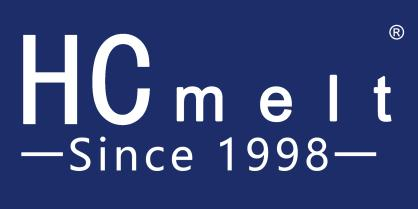

hot melt adhesives (HMAs), often called hot melt glue, are thermoplastic materials that are applied in molten form and then solidify upon cooling to form a bond. Their composition is carefully engineered to deliver strong adhesion, fast setting, and the required mechanical and thermal properties depending on the application. Below is a breakdown of the main components, common polymers used, additive types, and what to consider when selecting or formulating a hot melt adhesive.
There are three primary raw material groups in most hot melt adhesives:
| Component Type | Role / Function |
|---|---|
| Base polymer (thermoplastic resin) | Provides the backbone of the adhesive: gives the strength, flexibility, chemical resistance, melting behavior, and cohesion of the final adhesive. |
| Tackifier resins | Improve “tack” (initial adhesion), boost wetting of surfaces, modify viscosity and adhesion properties. Important for ensuring fast bonding and good contact with substrates. |
| Waxes and/or oils / plasticizers | Adjust the melt viscosity, control set or cooling time, improve flow during application, reduce cost, and modify hardness or flexibility. Waxes are solid at room temperature; oils/plasticizers tend to lower viscosity and soften the adhesive. |
To fine-tune performance (durability, appearance, environmental resistance, cost, etc.), HMAs often include smaller amounts of:
Antioxidants / stabilizers — to prevent degradation during melting/application and during service life (oxidation, heat, UV).
Fillers — to adjust thermal expansion, reduce cost, increase body or bulk, or adjust mechanical strength. Examples include calcium carbonate, silica, or talc.
Pigments or dyes — when color or appearance is a factor.
UV stabilizers / inhibitors — especially when exposure to sunlight is expected.
Different base polymers are chosen depending on required performance, temperature resistance, flexibility, cost, etc. Some of the commonly used ones:
Ethylene-vinyl acetate (EVA) — very common, especially in packaging, bookbinding, footwear; offers good balance of flexibility, adhesion, cost.
Polyolefins (PO) — includes amorphous polyolefins, polyethylene, polypropylene; often used where heat resistance or moisture/chemical resistance is needed.
Styrene-block copolymers (SBC) — e.g. styrene-butadiene-styrene (SBS), styrene-isoprene-styrene (SIS); used for pressure-sensitive hot melts, flexible applications.
Polyamides — for high strength, bonding difficult substrates, higher temperature applications.
Polyesters — similar to polyamides in some respects but generally higher moisture resistance, used in high strength + high temperature applications.
Reactive hot melts (e.g. polyurethane reactive, HMPUR) — these are thermoplastic when applied but then undergo additional curing (often by moisture) to form cross-links, improving heat, chemical, and solvent resistance.
When choosing or designing a hot melt adhesive, these are some key parameters:
Melt viscosity — must be low enough when molten to wet the substrate well; but not so low that it runs or flows excessively.
Set / open time — time during which the adhesive remains workable (before setting), and how fast it cures into a strong bond after substrate contact.
Temperature resistance — both service temperature (how hot or cold the bonded joint will be) and processing temperature (melting, application). Some HMAs must retain strength at elevated service temps.
Adhesion to substrate — depends on polarity, surface energy, roughness, presence of contaminants; choice of tackifier and polymer influences adhesion.
Mechanical properties — flexibility, toughness, elongation, shear strength, creep (under load), etc.
Durability — resistance to aging, UV, oxidation, moisture, chemical exposure. Additives like antioxidants, fillers, UV stabilizers help here.
Materials are measured and mixed through correct proportioning in heated mixing equipment. Polymer, tackifier, wax or oil, and other additives are compounded.
The molten mix is often extruded or pelletized into forms like sticks, pellets, blocks, or cakes, which later get melted again for application.
During application, the adhesive is heated to its melt temperature, applied, substrates are pressed, then cooling sets (solidifies) forming the bond. In reactive systems, further curing may occur after cooling.
Different applications require balancing cost vs performance. For example:
Simple packaging might use EVA-based adhesive with moderate tackifier and wax: relatively inexpensive, fast setting, adequate adhesion.
In automotive, aerospace, or outdoor exposure, higher performance adhesives like polyamides, polyesters, or polyurethane reactive types may be needed for heat, chemical resistance, durability.
For bonding plastics like polyethylene or polypropylene, nonpolar polymers (polyolefins) or specially formulated tackifiers are required.
Choosing the wrong base resin or wrong additive proportions can lead to poor adhesion, brittle bond lines, loss of strength under temperature, or excessive cost.
If you are looking for a quality source of hot melt adhesives, HUACHUN is a noteworthy manufacturer. Their website (hchotmelt.com) shows they specialize in a wide range of hot melt adhesive products, with experience in producing adhesives that meet various industrial needs. Whether you require adhesives with specific temperature resistance, rapid set times, or suited to particular substrates, HUACHUN offers options that are tailored for different requirements. Their commitment to product quality and technical support makes them a solid choice when sourcing hot melt adhesives.
Hot melt adhesives are sophisticated blends centered around a base polymer, supplemented with tackifiers, waxes/oils/plasticizers, and minor additives (like antioxidants, fillers, pigments) to achieve the desired performance. The selection of materials affects viscosity, strength, adhesion, durability, and cost. Firms like HUACHUN supply diverse hot melt adhesive products that reflect these design principles, helping customers find adhesives that match their specific needs.